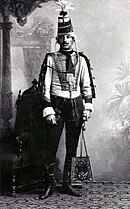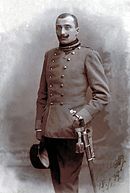Alexander Wassilko von Serecki (officer)
Count Alexander Wassilko von Serecki (born February 2, 1871 at Berhometh Castle ; † July 21, 1920 in Bârlad ) was the kuk chamberlain , chamberlain of Archduke Heinrich Ferdinand of Austria-Tuscany and a highly decorated lieutenant colonel of the kuk Bohemian dragoon regiment "Prince of Liechtenstein" No. 10 from the Wassilko family .
biography
Alexander was the son of Baron Alexander Wassilko von Serecki , the secret council of the same name and governor of the Duchy of Bukovina . He entered the Theresian Military Academy in Wiener Neustadt as a lieutenant on August 18, 1893, when he became a Kuk Galizisch-Bukowina'schen after private education and after completing his Abitur at the kk Staats-Ober-Gymnasium of Rădăuți ( German Radautz ) "Archduke Albrecht" Dragoon Regiment No. 9 assigned to Olomouc . On August 1, 1897 he was promoted to first lieutenant and assigned to the Kuk Bohemian Dragoon Regiment “Prince of Liechtenstein” No. 10, to which he belonged until the disintegration of the Danube monarchy .
Alexander was promoted to Rittmeister on November 1, 1907, and was appointed Head of Chamber on December 7, 1907 by Archduke Heinrich Ferdinand of Austria-Tuscany . Alexander accompanied him until the end of the war, and from 1907 until the beginning of the war lived with the art-loving Archduke in Munich (until 1912/13), then in Salzburg and Vienna . In 1909 he and his youngest son converted from the Orthodox to the Roman Catholic rite on the occasion of the celebration of the 60th anniversary of His Majesty's reign. In 1914 Alexander followed him to the 4th Army Command of Archduke Joseph Ferdinand of Austria-Tuscany .
The orderly officer experienced the war in Bukovina and Galicia from the very beginning, including the last cavalry battle in world history at Jaroslau am San and at Przemyśl against the tsarist forces .
In 1915/16 Alexander fought in northern Italy, including on Monte Baldo and in the South Tyrol offensive on Pasubio . He was appointed major on February 1, 1916 because of his service . As a result, he was seriously wounded and fell into French captivity, from which he was released again through diplomatic channels.
A special honor for him was the private audience with the Emperor, followed by Dejeuner on February 14, 1917.
In 1917/18 he followed Heinrich Ferdinand (meanwhile group commander, shortly thereafter major general) to the Carinthian front. For his commitment, Alexander was promoted to lieutenant colonel on May 1, 1918 , after he had already been awarded the Military Merit Cross (KD.) With swords 2nd class on April 27 of that year in recognition of brave behavior and excellent service in front of the enemy . The war on the front ended for Archduke Heinrich Ferdinand after his leave of absence on February 2, 1918. However, at his request, Wassilko was allowed to remain in the field. According to Freiherr von Wedel, he is said to have been the deputy of Colonel Maximilian Ronge in the registry office for a while and had previously performed secret service tasks. In this context it should be mentioned that he was also said to have played a role in the uncovering of the espionage case, Colonel Redl . This fact cannot be verified, but shortly after the discovery, on June 23, 1913, the Emperor awarded him the Officer's Cross of the Franz Joseph Order in recognition of long and excellent services.
On December 19, 1905, he was honored with the title of kuk chamberlain and by the highest resolution of August 29, 1918 in Eckartsau (diploma of October 19 in Vienna ) by Emperor Karl I because of his loyalty, his personal sacrifices and those of himself Family raised to the rank of count.
In 1919 he was taken as colonel after other lieutenant colonels in the Romanian army in the elite cavalry regiment Roşiori and awarded the Officer's Cross of the Order of the Crown of Romania. His military career ended when he committed suicide at the age of almost 50. He shot himself with his service weapon in the city park of Bârlad. According to a last letter to his wife Eva, the former kuk officer's reason for doing this was his desperation at the completely unacceptable working and living conditions in this army.
All family members of the Wassilko von Serecki family were originally of the Romanian Orthodox faith . Alexander converted to the Roman Catholic Church together with his son Georg in honor of the emperor in 1910 . Today his descendants live in Germany and Canada.
Awards (selection)
His medals included:
- Princely Liechtenstein anniversary commemorative medal, before 1910
- Jubilee Commemorative Medal for the Armed Power, before 1910
- Marian Cross of the Teutonic Order , before 1910
- Military Jubilee Cross , before 1910
- Royal Bavarian Order of Merit of Saint Michael 2nd Class , application for approval on December 16, 1911
- Officer's Cross of the Imperial Austrian Order of Franz Joseph , June 23, 1913
- Military merit medal "Signum Laudis" on the ribbon of the MVK , January 5, 1916
- Iron Cross 2nd class on white and black ribbon, approval from January 28, 1916
- Order of the Iron Crown 3rd Class (KD.) , February 24, 1917
- Military Merit Cross 2nd Class (KD.) With swords , April 27, 1918
- Officer's Cross of the Royal Romanian Order of the Crown of Romania
coat of arms
A blue shield, in which an upright arrow is surmounted by a crescent moon, the downward-facing tips of which are each studded with a six-pointed star, all of this golden. On the main edge of the shield rests the golden count's crown with nine visible pearl prongs, raised by an open, crowned tournament helmet, surrounded on both sides by blue, gold-backed ceilings. From the crown of the helmet emerges a natural peacock frond of two rows with five feathers each, shot right through by a golden arrow.
Below the shield there is a bronze-colored arabesque on which two upright natural stags, facing each other and holding golden crosses between their antlers, stand as shield holders.
family
The brother of Georg (1864–1940), Stephan (1869–1933) and Viktor (1872–1934) Wassilko von Serecki married Eva Anastasia Freiin Putz von Rolsberg on October 11, 1899 (* July 2, 1878 at Schloss Leitersdorf ; † 1 July 1946 in Troppau ), daughter of Karl Borromäus Ferdinand Putz von Rolsberg and granddaughter of Wilhelm Lenk von Wolfsberg . at Leitersdorf Castle near Troppau. Their marriage produced three children: Eva Lucretia (1902–1969), married to Ludwig Fürst zu Sayn-Wittgenstein (1900–1974), Carlo (1905–1989), former forest engineer, married to Elisabeta Conovici (1922–2010) among others and Georg (1908–1982), former director at Prodexport Bucharest and then journalist at Radio Free Europe in Germany , married to Elvira von Wiese (1915–1981). The two older children were born in Olomouc, his youngest son in Munich because of the Archduke's long stay there. During the entire war Eva lived with the children in a wing of the Salzburg residence , which belonged to Archduke Heinrich Ferdinand.
Picture gallery
literature
- The Gothaischen Genealogical Pocket Books of the Nobility S – Z, p. 606, GB 1919.
- Gothaisches Genealogical Pocket Book of the Count's Houses. Part B, pp. 536-537, Volume 114, 1941.
- Peter Broucek (ed.): A general in the twilight. Memories of Edmund Edmund Glaises von Horstenau. Verlag Hermann Böhlaus Nachf. GmbH, Graz 1980.
- Erich Prokopowitsch: The nobility in Bukowina. Publishing house "Der Südostdeutsche", Munich 1983.
- Johann Svoboda: The Theresian Military Academy in Wiener Neustadt and its pupils from the establishment of the institution to our day. Volume 2, Court and State Printing House, 1894.
- Theodor Ritter von Zeynek: An officer on the General Staff remembers. Böhlau Verlag GmbH, Vienna - Cologne - Weimar 2009, p. 196 ff.
Web links
Individual evidence
- ↑ Students in Radautz ( Memento from May 31, 2012 in the Internet Archive )
- ^ Johann Svoboda, The Theresianische Militär-Akademie zu Wiener-Neustadt and its pupils from the establishment of the institute to our days, Volume 2, Hof- und Staatsdruckerei, 1894, p. 855
- ↑ a b c Theodor Ritter von Zeynek, An officer in the general staff remembers, Böhlau Verlag GmbH, Vienna - Cologne - Weimar 2009, p. 196 ff
- ↑ a b 10th Bohemian Dragoon Regiment (1888) Liechtenstein, Johannes Joseph Fürst von, FM ( Memento from June 1, 2010 in the Internet Archive )
- ↑ Gertrude Enderle-Burcel, Johannes Kraus: “Mandatars in the corporate state: Christian - corporate - authoritarian: 1934–1938”, Documentation Archive of the Austrian Resistance 1991, p. 258
- ↑ Salzburger Chronik No. 33, from Saturday, February 12, 1916, p. 7
- ^ Eva Lucretia Princess zu Sayn Wittgenstein, Notes on the Wassilko Family, Hangu 1938
- ↑ Neues Wiener Journal No. 8367, from Thursday, February 15, 1917, p. 8
- ↑ Joint war edition of Czernowitzer Allgemeine Zeitung and Czernowitzer Tagblatt No. 230, from Sunday, May 19, 1918, p. 7
- ^ Ordinance sheet for the Austro-Hungarian Army of April 27, 1918
- ↑ Field sheet No. 1292, from Wednesday, May 15, 1918, p. 5
- ↑ Neue Freie Presse No. 19297, from Thursday, May 16, 1918, p. 8
- ↑ Peter Broucek (ed.): "A General in Twilight - Memories of Edmund Edmund Glaises von Horstenau", Verlag Hermann Böhlaus Nachf. GmbH, Graz 1980, p. 163
- ↑ a b c d e letter of nobility 1918
- ↑ Bukowinaer Post No. 3015, from Tuesday, June 24, 1913, p. 2
- ↑ Erich Prokopowitsch: The nobility in the Bukowina, Südostdeutscher Verlag, Munich, 1983, p. 130.
- ^ Heinz Sieghart (Ed.): "Adel in Österreich", Verlag Kremayr & Scheriau, Vienna 1971, p. 129
- ↑ Wiener Landwirtschaftliche Zeitung No. 5131, from Wednesday, March 15, 1916, p. 3
- ↑ Reichspost No. 114, from Saturday, March 10, 1917, p. 4
- ↑ Letter from the Oberhofmeister dated February 25, 1917, 1917 Pres. 61/4, No. 2065
- ↑ Wiener Landwirtschaftliche Zeitung No. 5385, from Wednesday, August 21, 1918, p. 181
- ^ Maximilian Mayerhoffer, family tree and evidence of nobility of the Putz von Rolsberg family
- ↑ a b Gothaisches Genealogical Pocket Book of the Count's Houses Part B, 114th year, 1941
| personal data | |
|---|---|
| SURNAME | Wassilko von Serecki, Alexander |
| ALTERNATIVE NAMES | Wassilko von Serecki, Alexander Freiherr; Wassilko-Serecki, Alexander Freiherr von; Wassilko-Serecki, Alexander Graf von; Vasilco de Serecki, contele Alexandru; Wassilko von Serecki, Alexander Graf (full name) |
| BRIEF DESCRIPTION | Austrian officer |
| DATE OF BIRTH | February 2, 1871 |
| PLACE OF BIRTH | Berhometh Castle |
| DATE OF DEATH | July 21, 1920 |
| Place of death | Bârlad |



















